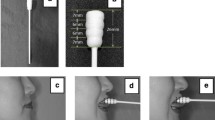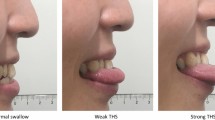Abstract
Tongue-hold swallow (THS) has the potential to be a resistance exercise not only for the pharyngeal constrictor but for the tongue muscles. To elucidate the physiological mechanisms of THS, this study investigated intraoral pressure generation during THS in relation to different extents of tongue protrusion. Tongue pressure was measured by a 5-point pressure sensor sheet placed onto the hard palate of 18 healthy young subjects who performed three swallow tasks: normal dry swallow, THS with slight tongue protrusion, and THS with greater tongue protrusion. Subjects randomly repeated each task five times. Maximum range of tongue protrusion was also measured in each subject to estimate lingual flexibility. With an increase in the extent of tongue protrusion, pressure generation patterns became irregular and variable. Duration of pressure generation increased with statistical significance in the posterior circumferential parts of the hard palate (p < 0.05). Maximal magnitude and integrated value of the pressure recorded at these locations increased in eight subjects as the extent of tongue protrusion increased, but it decreased in nine. The former group showed greater lingual flexibility, while the latter group exhibited less flexibility. THS may place different amounts of load on the tongue muscles by adjusting the degree of tongue protrusion.






Similar content being viewed by others
References
Fujiu M, Logemann JA. Effect of a tongue-holding maneuver on posterior pharyngeal wall movement during deglutition. Am J Speech Lang Pathol. 1996;5:23–30.
Zemlin WR. Speech and hearing science anatomy and physiology. 3rd ed. Englewood Cliffs: Prentice Hall; 1988.
Saigusa H, Yamashita K, Tanuma K, Saigusa M, Niimi S. Morphological studies for retrusive movement of the human adult tongue. Clin Anat. 2004;17:93–8.
Fujiu M, Logemann JA, Pauloski BR. Increased postoperative posterior pharyngeal wall movement in patients with anterior oral cancer: preliminary findings and possible implications for treatment. Am J Speech Lang Pathol. 1995;4:24–30.
Fujiu-Kurachi M. Symposium: EBM of dysphagia rehabilitation. EBM of the tongue-holding maneuver. Jpn J Speech Lang Hear Res. 2010;7:31–3.
Takemoto H. Morphological analyses of the human tongue musculature for three-dimensional modeling. J Speech Lang Hear Res. 2001;44:95–107.
Kokawa T, Saigusa H, Aino I, Matsuoka C, Nakamura T, Tanuma K, Yamashita K, Niimi S. Physiological studies of retrusive movements of the human tongue. J Voice. 2006;20:414–22.
Takahashi K. Effects of the tongue-hold swallow upon the electromyographic activities of the submental and infrahyoid muscles in young healthy adults. Unpublished master’s thesis, Niigata University of Rehabilitation, Murakami, 2011.
Ono T, Hori K, Nokubi T. Pattern of tongue pressure on hard palate during swallowing. Dysphagia. 2004;19:259–64.
Steele CM, Huckabee ML. The influence of orolingual pressure on the timing of pharyngeal pressure events. Dysphagia. 2007;22:30–6.
Stierwalt JAG, Youmans SR. Tongue measures in individuals with normal and impaired swallowing. Am J Speech Lang Pathol. 2007;16:148–56.
Utanohara Y, Hayashi R, Yoshikawa M, Yoshida M, Tsuga K, Akagawa Y. Standard values of maximum tongue pressure taken using newly developed disposable tongue pressure measurement device. Dysphagia. 2008;23:286–90.
Hori K, Ono T, Tamine K, Kondo J, Hamanaka S, Maeda Y, Dong J, Hatuda M. Newly developed sensor sheet for measuring tongue pressure during swallowing. J Prosthodont Res. 2009;5:28–32.
Gingrich LL, Stierwalt JAG, Hageman CF, LaPointe LL. Lingual propulsive pressures across consistencies generated by the anteromedian and posteromedian tongue by healthy young adults. J Speech Lang Hear Res. 2012;55:960–72.
Cohen J. Statistical power analysis for the behavioral science. 2nd ed. Hillsdale: Lawrence Erlbaum Associates; 1988.
Palmer A. Adult Dysphagia Rehabilitation Survey, 2009. Available at http://www/ohsu.edu/ent/gen/voice/voiceresearch.cfm. Accessed 12 August 2009.
Burkhead LM, Sapienza CM, Rosenbek JC. Strength-training exercise in dysphagia rehabilitation: principles, procedures and directions for future research. Dysphagia. 2007;22:251–65.
Clark HM. Neuromuscular treatments for speech and swallowing: a tutorial. Am J Speech Lang Pathol. 2003;12:400–15.
Tamine K, Ono T, Hori K, Kondoh J, Hamanaka S, Maeda Y. Age-related changes in tongue pressure during swallowing. J Dent Res. 2010;89:1097–101.
Solomon NP, Munson B. The effect of jaw position on measures of tongue strength and endurance. J Speech Lang Res. 2004;47:584–94.
Acknowledgments
This study was supported by a Grant from the Japan Society of Logopedics and Phoniatrics, and the Global COE Program of Osaka University.
Conflict of interest
None of the authors has financial or other relationships that would influence assessment of the data or that would constitute a conflict of interest.
Author information
Authors and Affiliations
Corresponding author
Rights and permissions
About this article
Cite this article
Fujiu-Kurachi, M., Fujiwara, S., Tamine, Ki. et al. Tongue Pressure Generation During Tongue-Hold Swallows in Young Healthy Adults Measured with Different Tongue Positions. Dysphagia 29, 17–24 (2014). https://doi.org/10.1007/s00455-013-9471-z
Received:
Accepted:
Published:
Issue Date:
DOI: https://doi.org/10.1007/s00455-013-9471-z




